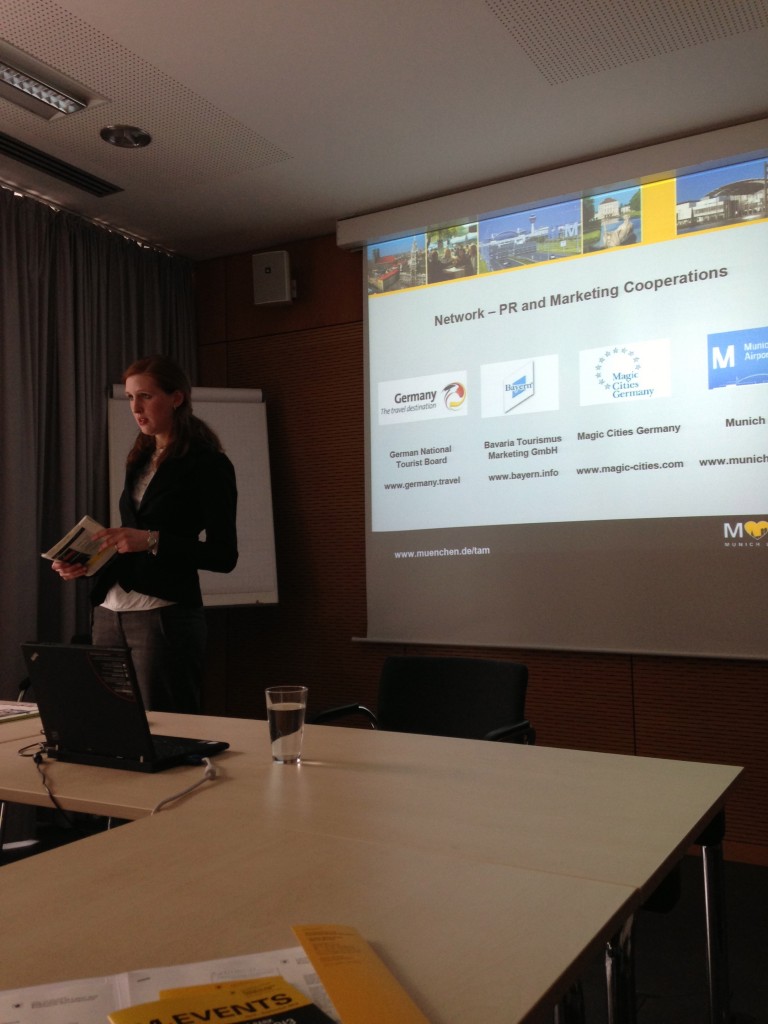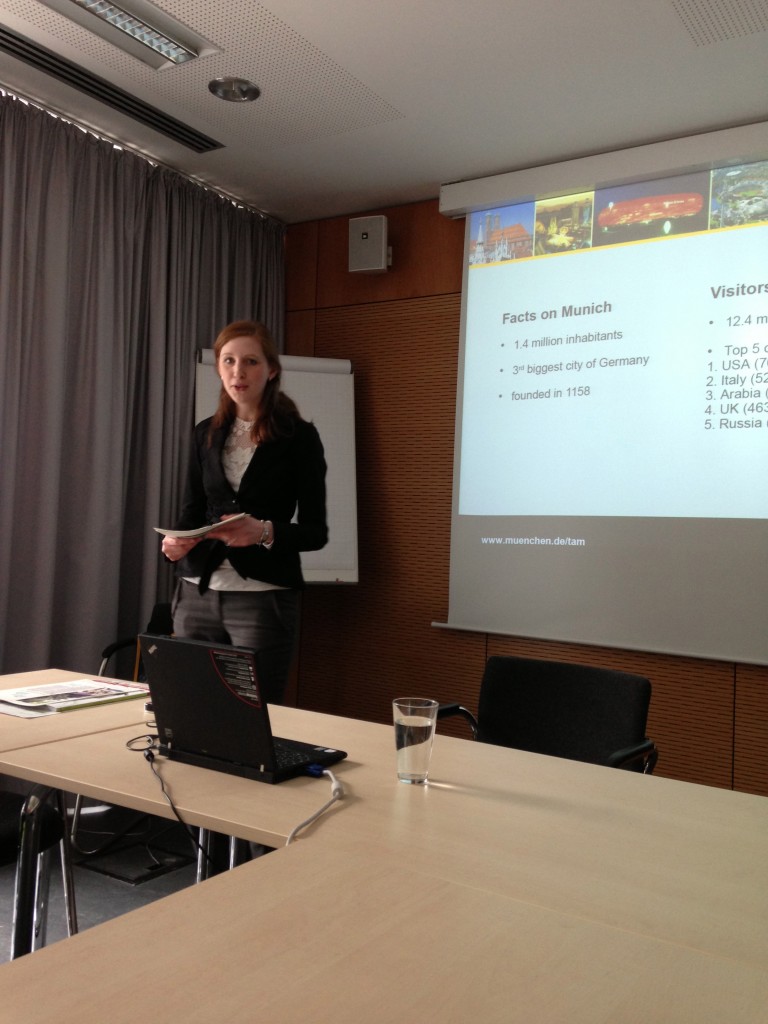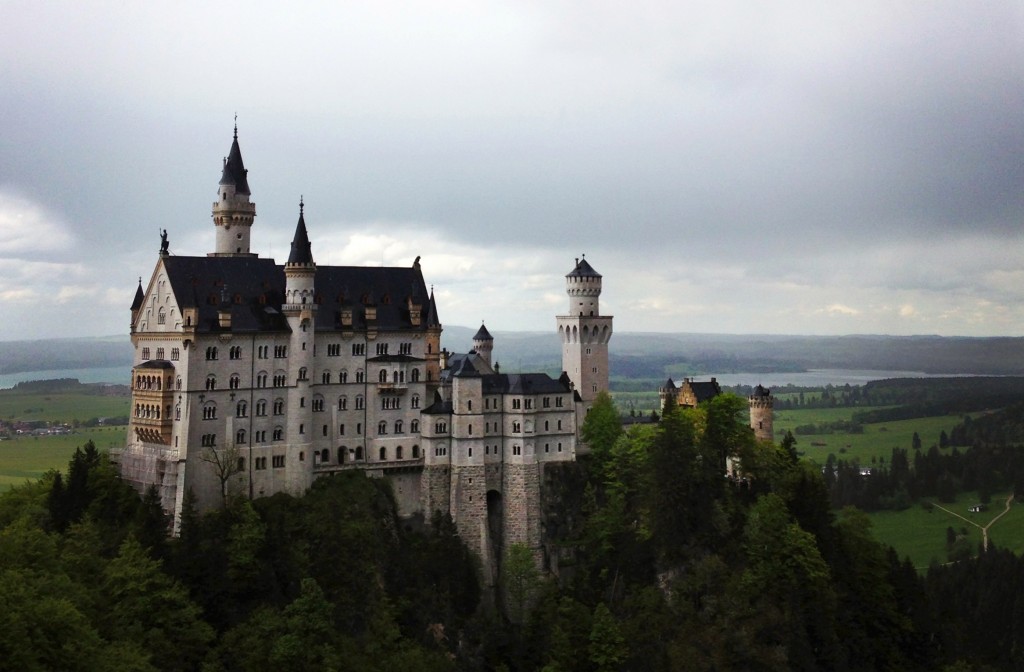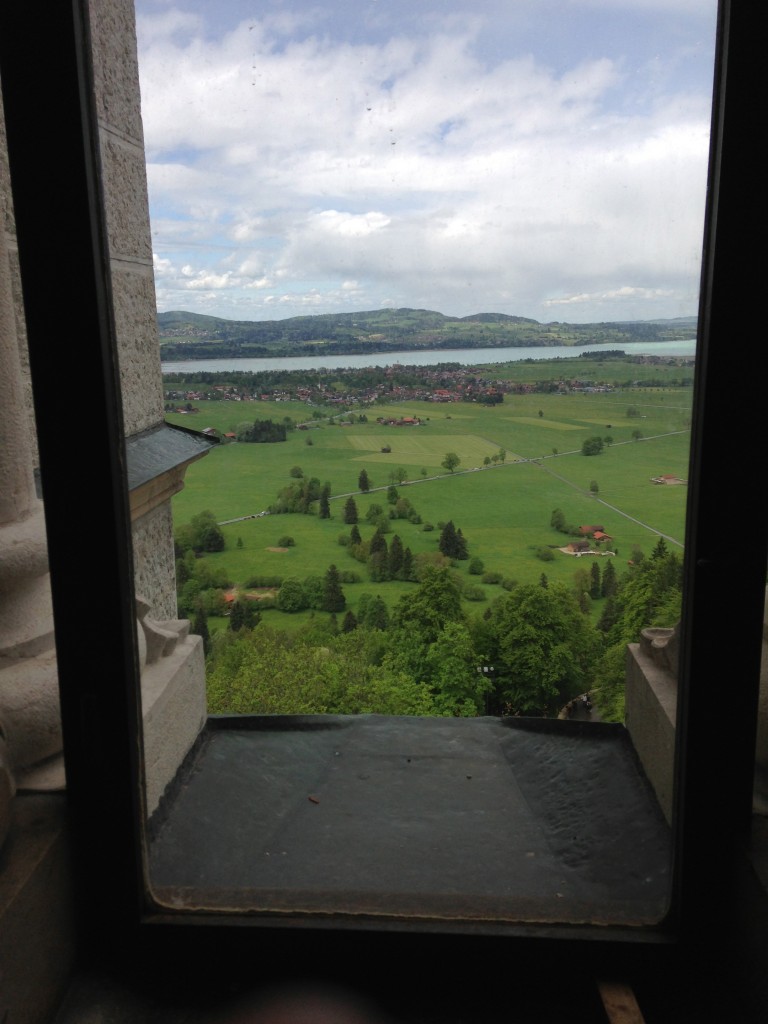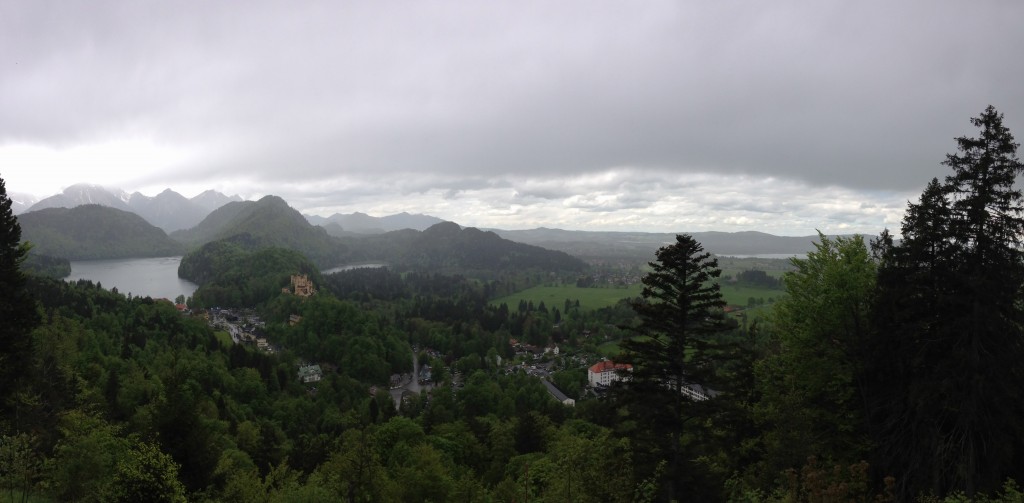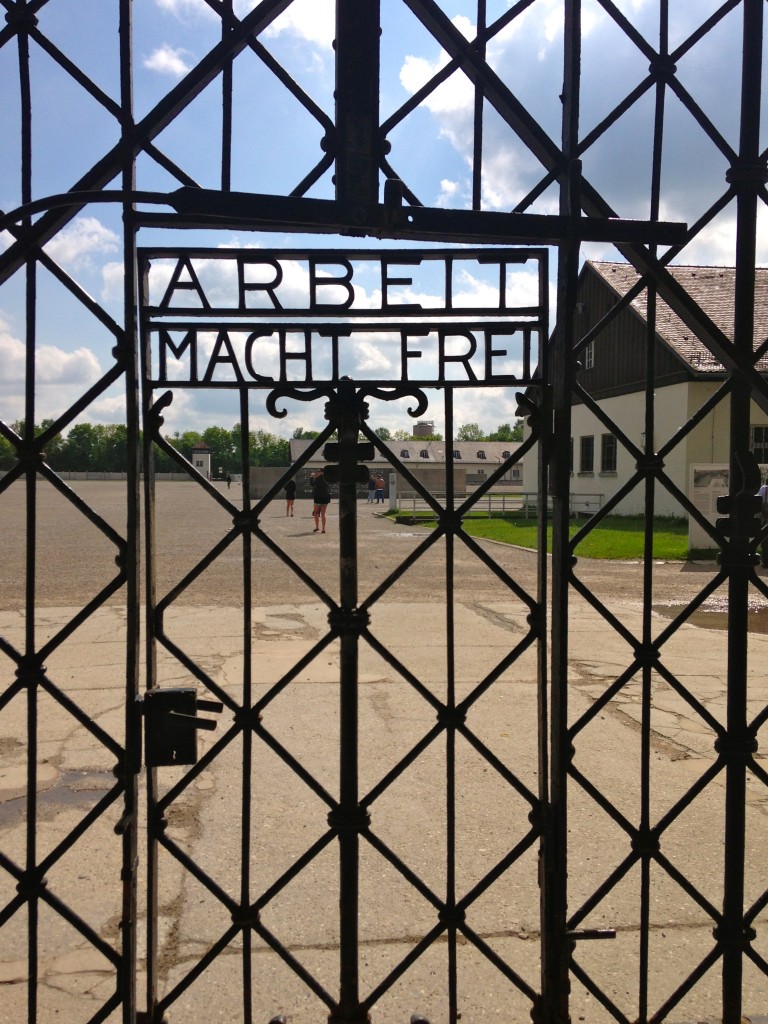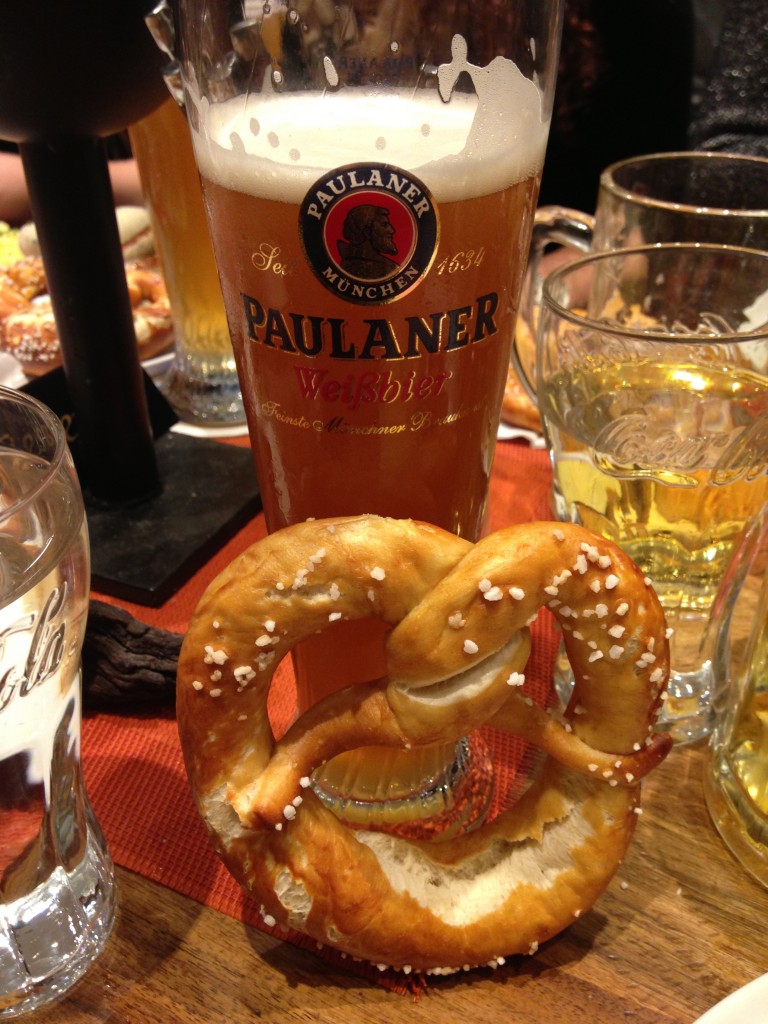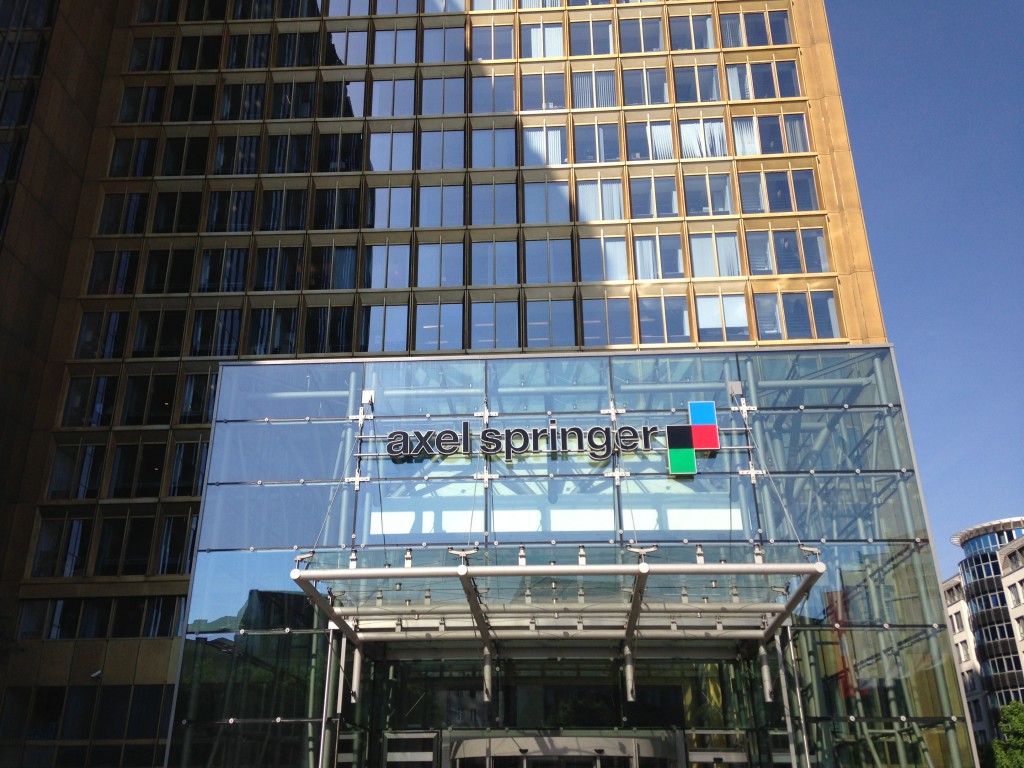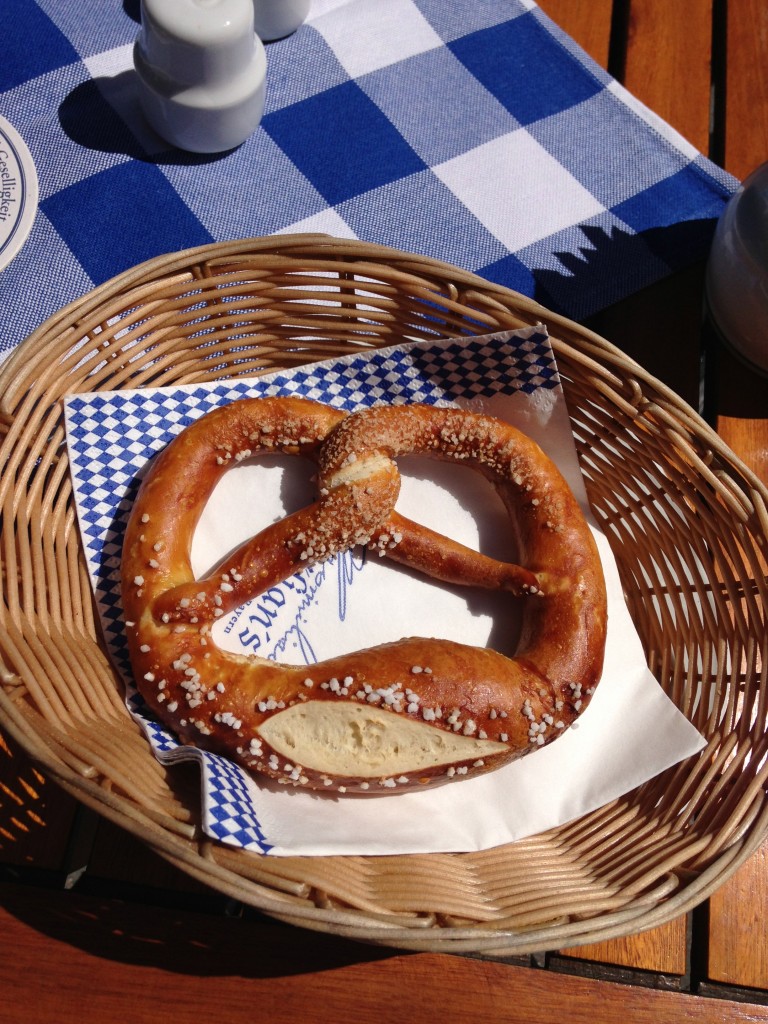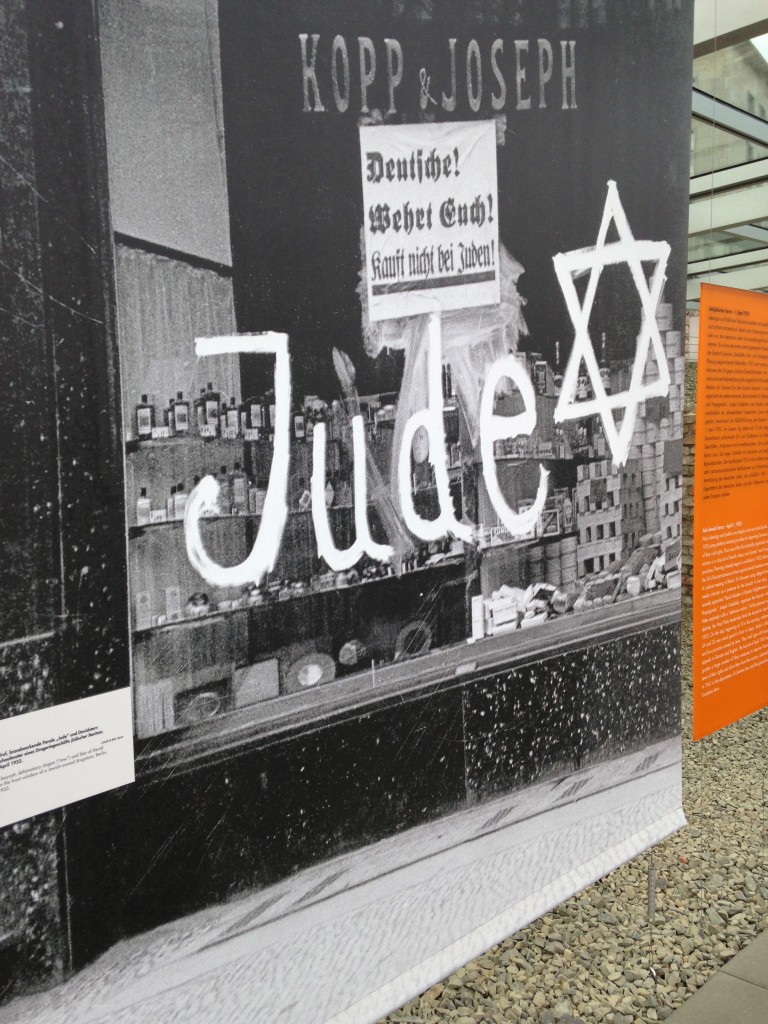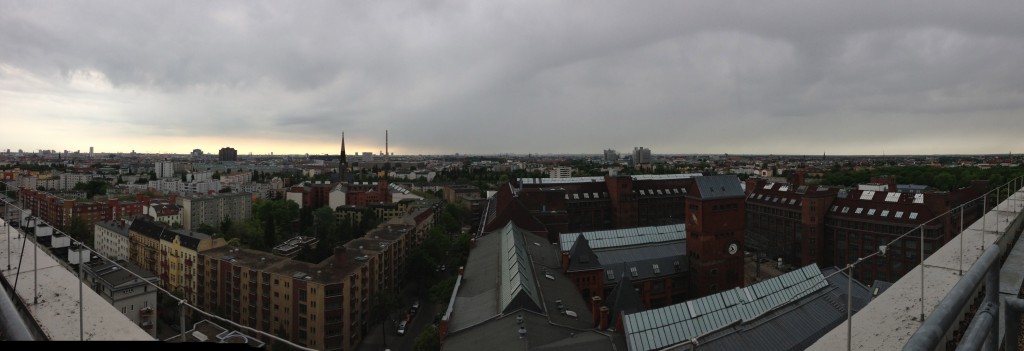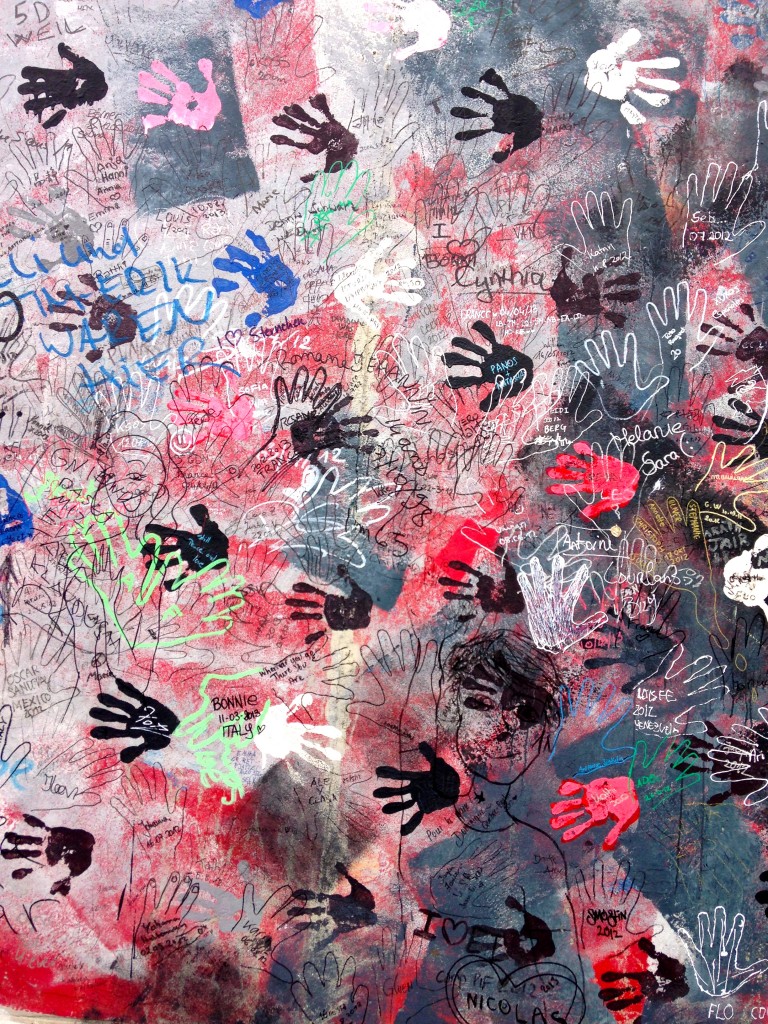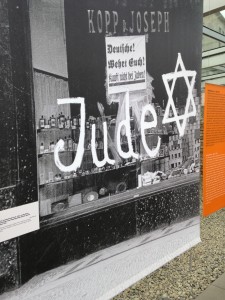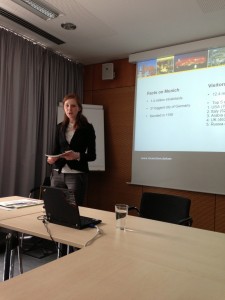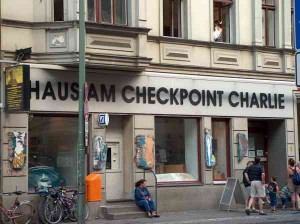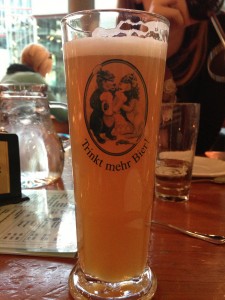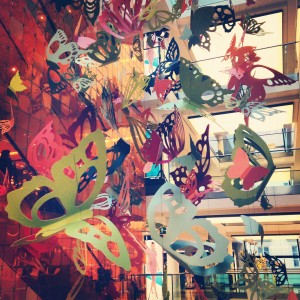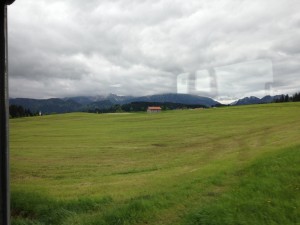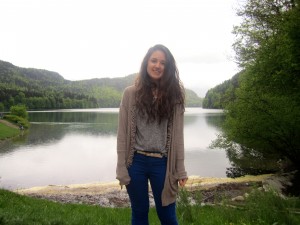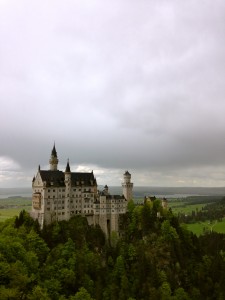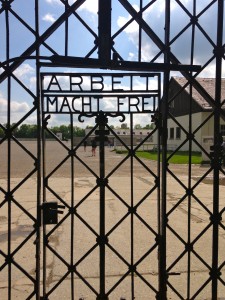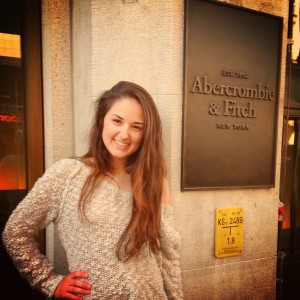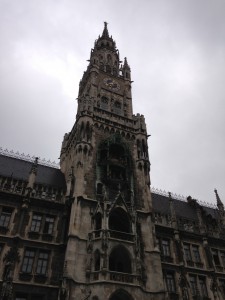Complete madness then, a beautiful museum now
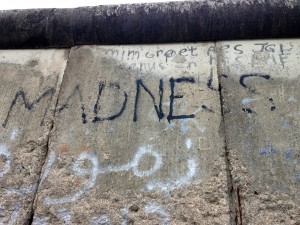
Part of the Berlin Wall, on the Topography of Terrors grounds, that reads “Madness”
(photo by Katie Pflug)
by Katie Pflug
Berlin, Germany’s Topography of Terror historic site is set on what used to be the site of the Reich Security Main office, but it is now a complex where visitors can learn more about the history of the Holocaust and the Nazi reign in Germany.
Even though National Socialist terror was planned and organized by other parties, the Reich Security Main Office was the center of most of the Nazi regime’s mass crimes and acts of terror. Between 1933 and 1945, the central institutions of Nazi persecution and terror – the Secret State Police Office with its own “house prison,” the leadership of the SS and, during the Second World War, the Reich Security Main Office – were located on the present-day grounds of the “Topography of Terror” that are next to the Martin Gropius Building and close to Potsdamer Platz, according to its website. It was just blocks away from the Suite Novotel, where the Point Park group stayed during its time in Berlin.
After the war the grounds were leveled and initially used for commercial purposes. Later, in 1987, as part of Berlin’s 750th anniversary celebration, the terrain was made accessible to the public under the name “Topography of Terror.” An exhibition hall and the exposed building remains on the former Prinz-Albrecht-Strasse (today’s Niederkirchnerstrasse) and Wilhelmstrasse were used to document the history of the site. The documentation center opened in 2010.
Now the grounds of the Topography of Terror have a haunted feel, almost as if visitors are being transformed back into that time period. It has part of the Berlin Wall as a backdrop, which adds more history and eeriness. There is a piece of the wall with the word “Madness” lightly written. This part of the wall stuck out to many visitors because many of them stopped and looked at the part of the wall particularly long. “The word [madness] describes how Germany was during that time period through the use of one word,” Andrea Karsesnick stated.
The outside exhibit begins with the year 1933, which is when the Nazi Party rise began. It was set up with large pictures, text, and propaganda posters. There are also other sections of the wall that are on their sides, with the metal exposed. The wall, in the form, looks like an art form.
It all starts in 1933 with “The Path to Dictatorship,” describing how Adolph Hitler came to power. This section of the exhibit is very time consuming but worth each second. It starts with describing the phase where Germany was between democracy and a dictatorship.
There is one picture in particular that stood out more than the others. The picture of the marching SS officers holding the flag with the Nazi symbol on it made it known to everyone that the Nazi Party was taking over. This photograph was taken in January 1933.
The Reichstag Fire and Nazi Terror in Berlin was another key section of the 1933 exhibit, explaining the burning of the Reichstag building. The burning of the Reichstag building, executed by a young Dutchman, Marinus van der Lubbe, led to the Nazi Terror taking place in Berlin.

The Topography of Terror, a commemorative site in Berlin, details the Nazi Party’s rise to power in 1933 through the end of the war and the Nuremberg trials. Here Professor David Fabilli views some of the public shaming Jews endured in the years leading up to the Holocaust.
(Photograph by Helen Fallon)
There are many propaganda posters hanging around the exhibit. Each of them offers an explanation of what each poster is trying to persuade everyone to think is right. Each of the photographs and propaganda posters really brought the exhibit to life.
In the middle of the 1933 exhibit there are separate hanging posters to remember some of the victims of Nazi Terror in Berlin. All of the victims’ photographs are accompanied by their personal stories that would make anyone sick to his or her stomach.
For example, Franz Wilczoch, a laborer, was taken to the district court prison on June 22, 1933. The Nazis were using the district court prison as a detention and torture center. When he was there, they severely maltreated him. His face was beaten with burning torches, they poured hot tar onto his wounds, his hair was cut or torn out, and he was plastered with adhesive tape. He died from his injuries on June 30, 1933.
The exhibit then goes into events happening later in 1933, such as the Anti-Jewish Terror, purges and employment bans, Day of National Labor and the destruction of the trade unions, book burning, and the consolidation of power.
After the 1933 exhibit there is much more to see inside the documentation center, which continues the timeline until beyond 1945 – from the start of the war, the “shamings” and public humiliation of remaining Jews, SS officers retreats, persecution of prisoners and Hitler’s opponents, to the trials of the leaders.
The grounds are landscaped with trees and a large pathway, which makes it easy to stop for a second and remember the terrible events that happened on that very location.
The pathway leads around all of the grounds and finally makes its way back to the documentation center. Information on the Gestapo and SS offices are just a few of the examples of history that is around the pathway.
The center also includes a library, open from 10 a.m. until 5 p.m.; guided one-hour tours are also available. No admission fee is charged, and the site operates from 10 a.m. until 8 p.m. daily. Staff members start closing the documentation center at 7:45 p.m. It is all wheelchair accessible.
According to its website, 900,000 people visited the “Topography of Terror” in 2012, making the documentation center one of the most frequently visited places of remembrance in Berlin.
PR shines at the Munich Tourism Office
by Katie Pflug
Isabella Schopp, who works in public relations for the Munich Tourism Office, really knows her facts about the third biggest city in Germany and was not shy to share them with Point Park University’s International Media class.
Munich, known as the “all around city,” is home to 1.4 million people. That number seems like nothing compared to the 12.4 million visitors Munich achieved in 2012, which was a record year. The United States of America, Italy, Arabia, The United Kingdom and Russia are among the countries with the leading amount of tourists that visit each year, Schopp said.
It also has the second largest number of universities, right after Berlin. Munich has 104,000 students in 15 universities, Schopp said.
Founded in 1158, Munich is now the center of science and economy. High tech industries like BMW, EADS, and The Linde Groupe all call Munich home. Google, Siemens and Microsoft are also some of the leading I&C companies in Munich. Munich is now the second largest city for broadcasting companies, right after New York City.
But, Munich has much more to offer than just being a great business hub. Munich is full of culture, castles, history, churches, shopping, beer gardens, all set in an amazing location.
There are 63 museums in Munich, along with 100 theaters, two operas and three orchestras. The Nymphenburgh Palace and Royal Residence are some of the castles in the area that are a must see while visiting Munich. Right outside of Munich there are also the castles Neuschwantstein and Linderhof. Castles are large part of Bavarian culture and a beautiful way to explore the history of the area.
Munich is a very green city with many parks. As well as the many parks throughout Munich, 80 percent of locals own a bike, Schopp said. The beer gardens also make many people want to be outside, she said. In this particular part of Germany, visitors are able to bring their own food to the beer gardens. That is something that is not permitted in the northern part of Germany. Beer gardens have been around 200 years and are some of the main attractions for visitors.
Munich is a very busy city for events. During February there was the Munich Creative Business Week. In May there was the Long Night of Music. Coming in June there will be the City Foundation Festival, celebrating 855 years of Munich. Later in June, Munich will be hosting the Summer X-Games, Schopp said. Of course in late September into early October there will be Oktoberfest, which marked its 200th anniversary in 2010. Then in the end of November all the way until Christmas Eve, the Christmas Market will be available to residents and tourists.
The Munich Tourism Board’s general manager is Geraldine Knudson. There are five different departments of the Munich Tourism Office: Marketing, Convention Bureau, Tourist Information, International Media and Public Relations.
The International Media is the branch of the office that Schopp is involved with, having previously served as a tour guide. She and her colleagues are responsible for the press kits, online image database, footage, the international newsletter, press trip assistance, film and photo permits, interviews. and research assistance.
Working in the International Travel Media section of the Munich Tourism Office are five colleagues and a trainee.
The Munich Tourism Office has professional photographers on staff, but sometimes it will buy photos from other journalists, Schopp said. The in-house photographers are responsible for the photo archives.
The Munich Tourism Office plays a big role in educating journalists and others about what Munich has to offer, she explained. And although Schopp will visit London and Paris to meet some of them and pitch Munich travel stories, “The journalists come to us for stories, not vice versa.” It also plays a huge role in organizing events such as Oktoberfest and the Christmas Market in Marienplatz.
The Munich Tourism Office works with the Germany National Tourist Board, which she said is its most important partner, the Bavaria Tourism Marketing GmbH, Magic Cities Germany and the Munich Airport to do its support work.
Journalists from Toronto Star, Budget Star, and Irish Times have all used the Munich Tourism Office for their resources. When the journalists check into the hotels they have a press kit waiting for them, Schopp said, and the Point Park students each received a scaled-down one as a sample. The press kit includes Munich Facts and Figures, a city map, a Munich City Guide, Munich Events, and Photo Services papers.
The press kits the Point Park group also had paperwork giving students and faculty permission to write, photograph and film within the city, something that is standard procedure for the Tourism Board to do for groups.
There are many different types of journalists that would find writing about Munich exciting as well as on-topic with their publication. Munich’s target market is really anyone because of the vast amount of things to do and a lot of families find that Munich is the perfect place to go because of that.
Visitors looking to stay in Munich will find no shortage of hotel rooms. There are around 300,000 hotel rooms in the city of Munich itself.
Schopp has been working at the Munich Tourism Office for three years and said she loves being in direct contact with the journalists.
More information is available on the city at the Munich Tourism Office’s website at www.meuchen.de or via email at travel.media@muenchen.de.
Stay in the east or flee to the west?
by Katie Pflug
Checkpoint Charlie was once a main crossing point between East and West Berlin and the Berlin Wall, but today it is a main historical attraction in Berlin, Germany.
The Checkpoint Charlie Museum may look like an old-fashioned home, but it is filled to the brim with historical remembrance of East and West Berlin.
Located near Potsdamer Platz, the Checkpoint Charlie Museum was erected in 1962 by freedom-fighter founder and director Dr. Rainer Hildebrandt. The museum started as a two and a half room apartment display that held history about the Berlin Wall. On June 14, 1962, the museum reopened in Friedrichstrasse in what used to be a block of flats, at the Checkpoint Charlie border crossing. Today it displays objects that helped escapees flee the East, exhibits to learn more about the history of the Berlin Wall and stories of escapees, according to its website.
Today the museum is run by Hildebrandt’s widow, Alexandra Hildebrandt, who, since the death of her husband in 2004, has expanded the museum to include more exhibitions about human rights and freedom.
The permanent exhibition dates back to the museum’s first days, just after the building of the Berlin Wall, and charts the lifespan of the world’s supposedly most secure border system, according to its website. Here visitors can see original boards created by Hildebrandt in the 1960s, who worked with journalists, escape organizers and protesters to put together a compact and clear outline of the background to the wall’s creation, as well as other key events in East Germany’s history, such as the June 17, 1953, uprisings.
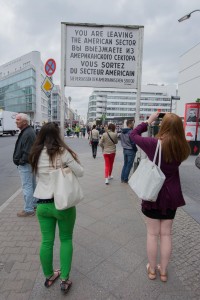
Katie Pflug and Michelle Graessle stop for a photo of the American sector exit sign.
(photo by Connor Mulvaney)
After viewing the first room, visitors walk up a staircase that has children’s paintings all the way up to the top of the stairs. Each of the paintings explains the separation between East and West Germany and how children wish they could all be friends. The paintings and drawings add a child’s perceptive to the museum, which gives visitors another great way to think about how the Berlin Wall affected so many people’s lives.
Throughout the whole museum there are many displays that shows objects that helped East Berliners escape to the west. From suitcases and heaters to escape cars, hot air balloons, homemade mini-submarines and deceptively hollow surfboards are just a few of the items that people used to escape. Reading the stories left many visitors looking shocked.
The museum displays a homemade airplane that was used as an escape method. The only part of the plane that was not homemade was the engine, which was taken out of a car.
The museum also has on exhibit other work describing human rights violations around the world and a permanent NATO exhibition.
Point Park students found the Checkpoint Charlie Museum a great way to learn more about what was happening while the wall was up in Berlin. The museum is heavy on reading, student visitors said, but each and every display is worth taking the time to read and understand.
The museum is open every day of the year from 9 a.m. until 10 p.m., including festivals such as Christmas and Easter and other bank holidays. Admission charges are 12.50 euros for adults, 8.50 euros for groups of 20 or more, and 9.50 for students and 6.50 for ages 7-18. Children up to 6 are free. Guided tours are available.
A Final Goodbye to Munich
Wednesday May 22, 2013
Today was a busy last day! But, there is absolutely nothing wrong with being busy with media visits! The wake up call was also a bit later today, which was nice because I was needing some extra sleep. Even though I did not do anything too crazy last night it still feels like I will forever be catching up on sleep.
We started the day of with visiting Ketchum Pleon, which was the media visit during the trip I was looking the most forward to. It was a very interesting presentation that was made by 4 of the employees at Ketchum Pelon. I am an Advertising and Public Relations major, so this whole visit was very interesting to me.
My favorite part of the presentation was the Social Media portion. I took a Social Media class this past semester and became very interested in learning more about Social Media Careers. I love the video about the movie star having gas. I found it very interesting that they made such an uncomfortable topic so funny and easy to talk about.
I also really enjoyed that each of the visits that we went on were so gracious with their hospitality. We can each really be thankful that they were excited to talk to us about their company.
Later in the day we went to Suddeutsche Zeitung, the top newspaper in Germany. Their building is newer and the design, inside and out, was amazing. Since I am not a Journalism major I did not think that I would be so interested in each of the print journalism visits we went on. The most interesting part of the SZ visit was seeing all of the amazing advertising. I loved how creative and innovative they were with each of their clients. I have never seen anything like that in the States. Between the scented ads, the see through ads, and the huge full page spreads they all really brought the advertising to life.
I will have to wait a few more months till I can legally drink beer back home, I will really miss having the freedom of sitting down at lunch and grabbing a beer.
We had our final group dinner at the Ratskeller, which is right in the city center. I have had so many pretzels on this trip, but each one gets better and better. The dessert was also amazing and I loved the texture! It was a great way to say goodbye to Munich!
Off to bed for an early morning flight and a safe trip home! See you soon, Germany!
Xoxo
Katie
A Not So Mini Day
Tuesday May 21, 2013
Today was the first media visit we had, in what seemed like, weeks. We were privileged enough to visit BMW. Not only did we get the inside scoop on the new green BMW cars, but we also got a tour of the museum! I did not think I would enjoy this visit very much since I am not into cars, but I was so wrong! This was defiantly one of my favorite visits so far!
There were many amazing things that I enjoyed learning about in each of the parts of the day at BMW. I loved learning about the different laws that Germany has with the cars that are very different than the United States. Another part of the presentation that interested me was that BMW is doing so many other things other than just producing cars. All of the apps for smartphones seemed to be very helpful and I am going to download a few of them once we get home.
BMW also treated us to an amazing lunch at one of their cafes. The food was amazing, just like their hospitality they showed towards us.
After lunch we went on a tour of the BMW museum. I loved seeing the Mini exhibit because they are my Mom’s favorite cars and I also think they are adorable! Also, after seeing the VIP treatment that you can get if you pick up your new BMW in Munich makes me want to do that someday. It was amazing that they had so many services for the new car owners.
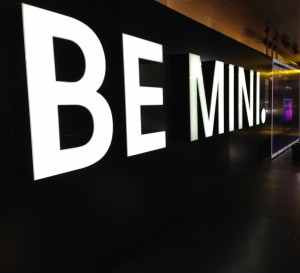
Later in the day I was able to explore Munich on my own, which I am very proud of. I took the one of the S bahns to one of the shopping areas a bit past the city center. I had to return a dress, but of course I bought a new one. I love shopping by myself because I can take as much time as I want to wonder around and not have someone telling me to hurry. It was also nice to take in some of the last sights since it was our final amount of free time. I went into a huge upscale department store, which was decorated incredibility.
Later that night, Andrea and I just hungout and grabbed some dinner in the train station. It is always interesting going to the train station because there are also so many different and unique people.
I cannot believe tomorrow is our last day! The trip went so quick and I will be sad to leave Germany.
Xoxoxo
Katie
A Magical Day in Germany
Monday May 20, 2013
Today was the day I was looking most forward to from the start of the trip! I love visiting castles, but there was something that made this castle look extra amazing in all of the pictures that I have seen before. We started off the morning by taking the train about 2 hours to a little town near the castle. The train ride was even better than the day before when we traveled to Austria. We got to see even more of the Alps, which I think are amazing, and more rolling farm land. The train ride there was impossible to sleep through for me because I did not want to miss the amazing scenery.
When we arrived to the train station right outside the little town the castle was in we took a bus to the castle. It was a short ten minute ride and on the way up a winding road we saw the castle in the distance, from that point I could hardly contain my excitement!
Went we got to the little town the castle was in our first stop was the lake. At this point we were in the Alps and each and every view was amazing. Neuschwanstein was in plain sight wherever you walked in the village, and I loved that! After visiting the amazing lake we went to lunch and got some shopping done.
Then, it was finally time for the walk up the mountain and tour of the castle. The walk up was hard, but at the end very rewarding. It is not every day that you can say you climbed the Alps to see a castle! When we got to the top one thought went through my head, how did they possibly build that? After getting many pictures of the castle and in front of the castle it was time for the tour.
I wish the weather would have been a little bit less rainy, though. I felt like I had to keep taking my umbrella in and out of my purse, which got to be a pain. I also would have look much better in all of my pictures it the rain would have held off.
After going inside Neuschwanstein we learned that it is less than 150 years old, which blew my mind. Everything inside was so amazing and looked like new. All of the woodworking, paintings, furniture and light fixtures were perfect. I wish I could live there! My favorite part of the inside the castle was the view that you could see outside. The windows either overlooked mountain lakes and country land or the wooded Alps which were both were amazing.
After the guided tour we decided to take another hike up to the bridge that over looks the castle. The hike was a super quick struggle in the rain for a breathtaking view. I am not a fan of wobbly, old, and wet bridges, but I knew I had to walk out and see the famous view. As soon as I saw the view it took my breath away and it seemed like nothing else mattered in the world.
The whole day at Neuschwanstein was picture perfect, other than the rain. It was something that I will remember forever and will always look back on. Even though it was a long day I would not have spent it any other way.
Xoxoxox
Katie
I am 16 Going on 17
Sunday May 19, 2013
After an amazing night in Munich it was time to catch the train to Salzburg, Austria! Salzburg is home to the “Sound of Music”, so I knew this side trip would have many great sights. We caught the train at the train station right across from our hotel, which is very convenient, and had a quick 2 hour ride to Salzburg. The trip there was amazing. We rode right through the countryside and had am amazing view of the Alps the whole time. I couldn’t believe that some of the mountains that we saw still had snow on the upper ledges!
When we arrived it was a race to find lunch, we were all so hungry! After a quick lunch we met our tour guide who gave us an in-depth tour of Salzburg. We visited the gardens that were used in the “Sound of Music” movie, along with amazing scenery, magnificent churches, the Alps, and the home of Mozart. Salzburg had such a rich history between the “Sound of Music” and Mozart.
My favorite part of the tour was walking through the gardens. The landscaping was so beautiful and the flowers were so bright! The statues were also, in a way, very whimsical. The unicorn statue was my personal favorite because a unicorn isn’t even a real creature! It also blew my mind that the same flower patterns were showed in the movie. The gardens also gave an amazing view up to the Alps.
After the tour Andrea and I walked around the city for a bit. At this point it started raining, so we were both glad we remembered our umbrellas! I really think that Salzburg is the trinket capital of the world, in each store we went into there were, what seemed to be, billions of little trinkets.
After a long day in Salzburg we all met for a group dinner, which included chicken! That was the first time on the trip that one of our group dinners included chicken, which was amazing.
The trip back to Munich was very relaxing after the long and wet day in Salzburg. I got so many amazing pictures from the day and I cannot wait to print some out!
Xoxo
Katie
A Day to Remember the Past
Saturday May 18, 2013
After resting up from the first half of the trip I feel refreshed and ready to go! Good thing I feel that way because we did a lot today, and much more is coming later this weekend. Today was a very moving day, which was followed by some shopping.
This morning we were privileged enough to visit Dachau Concentration Camp. I figured that the experience would be very emotional and moving, but it was much more than just those two emotions. Seeing all site that so many people died on had a very chilling effect. Knowing that we were all walking on their ashes, even if they were covered by stone, made the whole thing really emotional. To know that so many people died in one area is heart-breaking.
We had a tour of Dachau, which included the sleeping area, gas chambers, crematorium, and memorials. The sleeping areas held so many people in one section and I could never imagine having to live like that. It really makes you thankful for what you have. Many people complain about how small their dorm rooms are, but after seeing what conditions the concentration camp victims lived it I will never want to complain about a living situation again.
The museum and movie were also informative and interesting. I have always had an interest in Holocaust history and it was great to learn more about it at an actual concentration camp. The main part of the museum that stuck out to me was pictures of the survivors. Each one of them were smiling in their picture even after everything that has happened. That really showed me to never give up and there will be a light shining at the end of a dark tunnel.
The landscape around the concentration camp seemed very quite and desolate. It was very flat and the trees were very tall. The landscape of Dachau gave the area a very spooky feeling.
Later in the day, Andrea and I went on a little shopping adventure. We both work at Abercrombie and we wanted to go find the one in Munich. It was quite the sight to see! We heard a rumor that if you show your employee card to the model working the door you will not have to stand in line, which was somewhat true. I went up to show my employee card and the model told me to go ring the door bell on the next door over. We did just that, but little did we know that only works if you are an employee at that particular store, oops! We waited in line just like everyone else and were very impressed with the inside.
Our shopping trip was pretty successful and full of exploring. Later at night the whole group of us decided to meet up with some of the other Point Park students that have their internship abroad this summer. Their hostel was right down the road from our hotel so it was really great to see all of them! One of my best friends, Jordan, was there so it was nice to see him for the last time this summer.
Xoxoxo
Katie
Let’s Fly Away to Munich
Friday May 17, 2013
At this point in the trip I have lost track of how many days we have been away. Today we started the day off with a super quick flight from Berlin to Munich. It was sad to leave Berlin, but so far I believe I will enjoy Munich much more.
The flight this morning was actually quite enjoyable and gave us a quick hour to catch up on our sleep. They even gave us chocolate hearts when we got off the plane!
Once we arrived to Munich we met with our new tour guide. He took us back to the hotel while pointing out so key attractions in Munich. The impression I got from Munich right off of the bat is that it is much more European than Berlin. It also seemed like it was a much more tourist based, which we later found out was true.
The walking tour was beautiful. We walked around the main part of Munich and saw many great churches and other attractions. Our meeting point for the day ended up being the glockenspiel, which was huge and very hard to miss. I loved all of the creatures that were on the outside of the building. Each one was very full of character and seemed to be different than the next one.
I had so many great pretzels to eat today! Not liking many of the German foods is becoming hard, but at least I love the pretzels. There was this adorable Pretzel place in the S and U Bahn station that I really want to try out. I also had a great beer at dinner. It was very light, which I love, and also tasted a bit like lemonade. Now I see why the Germans like beer and pretzels so much!
The media visit today was short, but very sweet. Isabella was very informative about the Munich Tourism Office, she even gave us some handy packets with loads of information inside! I found it very interesting that the Munich Tourism Office plans Oktoberfest. Another thing that interested me was that they were not allowed,, by the Munich law, to use Social Media. That is such a large part of the American business plan that it really blew my mind that they did not have any forms of Social Media.
Today was also a great day to relax. At this point of the trip I think everyone is starting to get very tired. Today I think I caught up on all of my sleep after dinner, so I should be ready to go for the rest of the trip!
Xoxoxo
Katie

